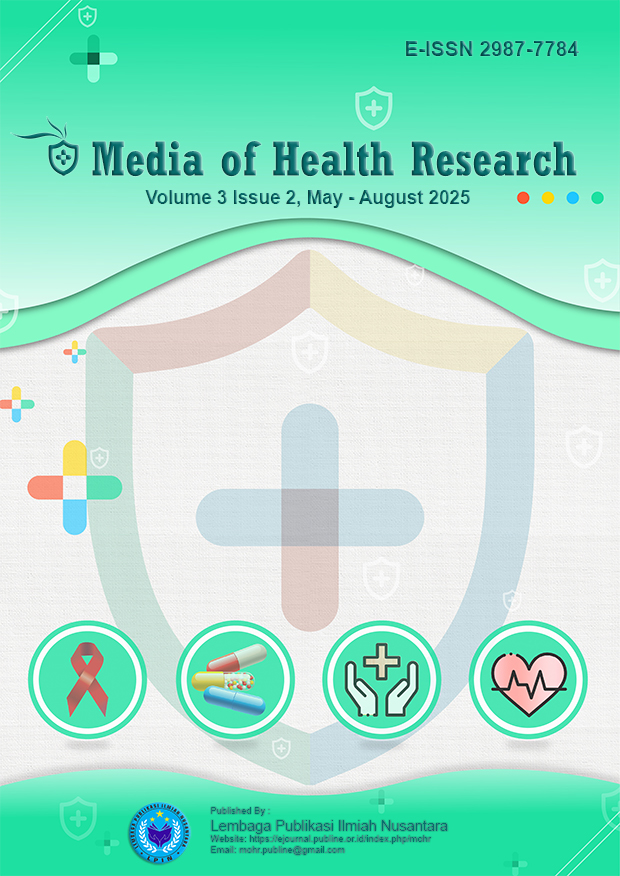Evaluation of the Effectiveness of Mobile Applications for Monitoring Blood Sugar in Type 2 Diabetes Sufferers
DOI:
https://doi.org/10.70716/mohr.v3i2.239Keywords:
mobile health, type 2 diabetes, blood sugar monitoring, self-management, digital health applicationsAbstract
Background: The growing prevalence of Type 2 Diabetes (T2D) demands innovative approaches for self-management. In recent years, mobile health (mHealth) applications have emerged as practical tools for monitoring blood glucose, offering real-time data access, reminders, and personalized feedback. Objective: This article aims to evaluate the effectiveness of mobile applications in supporting blood sugar monitoring and management for individuals with T2D. Methods: This study employed a descriptive qualitative method using a literature review approach. Data collection involved academic document analysis sourced from Google Scholar, including scientific journals, books, and conference proceedings. Thematic content analysis was applied to identify key findings, patterns, and implementation strategies. Results: The study revealed that mobile applications facilitate improved glycemic control, better adherence to self-monitoring routines, and increased user engagement through real-time feedback and educational features. Key strategies include daily tracking, visual data representation, and personalized goal setting. These features positively impacted users’ motivation, health literacy, and decision-making autonomy. Conclusion: Mobile apps serve as effective mediators between clinical guidance and patient self-management. They foster a proactive health culture, empower patients, and enhance overall diabetes care outcomes.
Downloads
References
Ariffin, K., Baharum, N. D., & Abd Wahab, R. (2017). Language Use as Audience Design. Gading Journal for the Social Sciences (e-ISSN 2600-7568), 20(02). https://doi.org/10.24191/gading.v20i02.190
Goffman, E. (1967). Interaction ritual: Essays on face-to-face behavior. Anchor Books.
Holmes, J., & Wilson, N. (2022). An introduction to sociolinguistics. Routledge.
Hymes, D. (1972). On communicative competence. sociolinguistics, 269293, 269-293.
Ishihara, N. (2010). Instructional pragmatics: Bridging teaching, research, and teacher education. Language and Linguistics Compass, 4(10), 938-953. https://doi.org/10.1111/j.1749-818X.2010.00242.x
Kubota, M. (1995). Teachability of conversational implicatures to Japanese EFL learners. IRLT Bulletin, 9, 35–67.
Koike, D. A. (2009). Pragmatic instruction in foreign language contexts. Pragmatics and Language Learning, 12, 1–26. Soler, E. A., & Martínez-Flor, A. (2008). Pragmatics in foreign language contexts. Investigating pragmatics in foreign language learning, teaching and testing, 30(1).
Koike, D. A., & Pearson, L. (2005). The effect of instruction and feedback in the development of pragmatic competence. System, 33(3), 481–501. https://doi.org/10.1016/j.system.2005.06.008
Labov, W. (1972). Sociolinguistic Patterns. University of Pennsylvania Press.
Lasala, C. B. (2014). Communicative competence of secondary senior students: Language instructional pocket. Procedia-Social and Behavioral Sciences, 134, 226-237. https://doi.org/10.1016/j.sbspro.2014.04.243
Liddicoat, A. J., & Crozet, C. (2001). Acquiring French interactional norms through instruction (pp. 125-144). Cambridge University Press.
Li, S., & Taguchi, N. (2014). The effects of practice modality on pragmatic development in L2 Chinese. The Modern Language Journal, 98(3), 794-812. https://doi.org/10.1111/modl.12123
Li, Q. (2012). Effects of instruction on adolescent beginners’ acquisition of request modification. Tesol Quarterly, 46(1), 30-55. https://doi.org/10.1002/tesq.2
Li, X. (2010). Sociolinguistic variation in the speech of learners of Chinese as a second language. Language Learning, 60(2), 366-408. https://doi.org/10.1111/j.1467-9922.2009.00560.x
Richards, J. C., & Rogers, T. S. (2014). Approaches and Methods in Language Teaching (3rd ed.). Cambridge University Press.
Rose, K. R. (2005). On the effects of instruction in second language pragmatics. System, 33(3), 385-399. https://doi.org/10.1016/j.system.2005.06.003
Sarimsakova, D. M. (2021). Developing the sociolinguistic competence of future English teachers through the use of case studies. Mental Enlightenment Scientific-Methodological Journal, 54-65. https://doi.org/10.37547/mesmj-V5-I6-10%20
Susilawati, E. (2024). Developing sociolinguistic context-based English-speaking materials for Islamic senior high school students. English Language Teaching Educational Journal, 7(1), 24-42. https://doi.org/10.12928/eltej.v7i1.10065
Taguchi, N. (2015). Instructed pragmatics at a glance: Where instructional studies were, are, and should be going. Language Teaching, 48(1), 1-50. https://doi.org/10.1017/S0261444814000263
Taguchi, N. (2011). Pragmatic development as a dynamic, complex process: general patterns and case histories. The Modern Language Journal, 95(4), 605-627. https://doi.org/10.1111/j.1540-4781.2011.01246.x
Taguchi, N. (2011). Teaching pragmatics: Trends and issues. Annual review of applied linguistics, 31, 289-310. https:// doi:10.1017/S0267190511000018
Wardhaugh, R., & Fuller, J. M. (2015). An Introduction to Sociolinguistics (7th ed.). Wiley Blackwell.
Downloads
Published
How to Cite
Issue
Section
License
Copyright (c) 2025 Dehen Djata, Nguyen Pham Hoang

This work is licensed under a Creative Commons Attribution-ShareAlike 4.0 International License.











